How the Greek home of the Olympics is keeping the flame alive for visitors
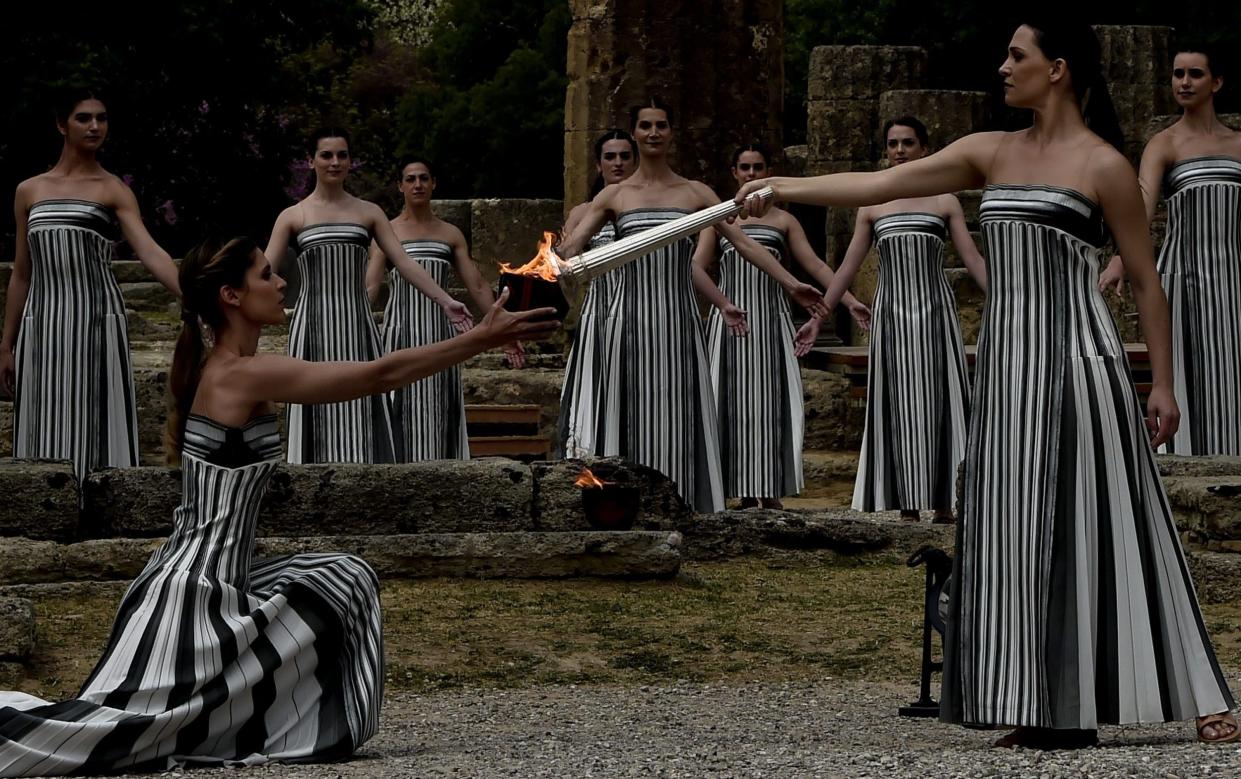
Nowhere does organised chaos quite as splendidly as Greece. And as with other facets of life in the country at Europe’s southern foot – marble statues on olive tree hillsides; the words of ancient poetry and philosophy; jumbled piles of crumble-cheese salad; the flicker of sunlight on an Aegean harbourside – it is delivered as something of an art form.
Take, as an example, the scene at Olympia last week, as the Olympic flame was lit, ahead of the forthcoming Summer Games in Paris (July 26 to Aug 11). If you glimpsed the event via a television screen, you saw only artistry and elegance – the actress Mary Mina taking on the role of the High Priestess in the Temple of Hera, the flame carried into view from behind her, from within the remaining pillars of this relic of the sixth century BC. From there, it was borne into the stadium area of the Olympics’ spiritual home, where the torch’s epic journey to France commenced with the Greek rower Stefanos Ntouskos, who took gold in the men’s single sculls in the Covid-delayed Tokyo Games, three years ago.
All glamour, all glory.
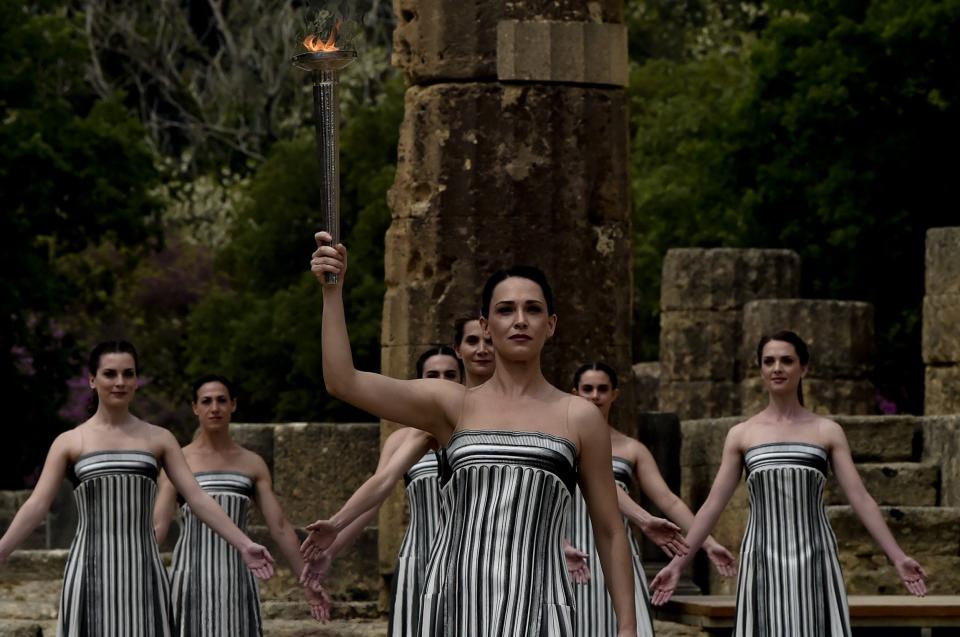
What you did not see were the sleights of hand – that the flame was not ignited, as is traditional, via a parabolic mirror and the Mediterranean sun’s direct rays, but from a back-up fire, kindled the day before at the rehearsal, on the off-chance that – as proved to be the case – the sky would be overcast at the key hour. And you probably did not see the mutterings in the Athenian press that the long, black-striped print dresses worn by Mina and her fellow “priestesses” – created by the London-based Greek fashion designer Mary Katrantzou – were insufficiently ancient in their shape, and style, to be fit for the purpose.
Nor did you see the chaos. The wonderful chaos.
As a media invitee, I had been told to expect all manner of bureaucracy. I had supplied my personal details weeks in advance, swapping them for a suitably laminated entry pass. I was carrying my passport, in case this needed to be rechecked and cross-referenced against the guest list. I expected lines, clipboards, order befitting a rite of some solemnity.
In retrospect, I have been in the country often enough to know that such matters are not generally Greek touchstones. Instead, what I encountered that Tuesday lunchtime was a carnival in giddy progress; a party at the heart of the modern town of Olympia that every citizen seemed to be part of – loitering, milling, stepping into roads oblivious to the many cars and tour buses trying to inch along them, sipping coffee, smoking on street corners. There were men in a range of uniforms, “marshalling” the situation with various levels of disengagement. There were groups of schoolchildren, in different sets of matching coloured T-shirts (red, yellow, green, blue, black), who would eventually morph into the five Olympic rings on the bank of grass above the ancient stadium – but who, for now, were as blithely untethered as any youngster given a day out of the classroom tends to be.
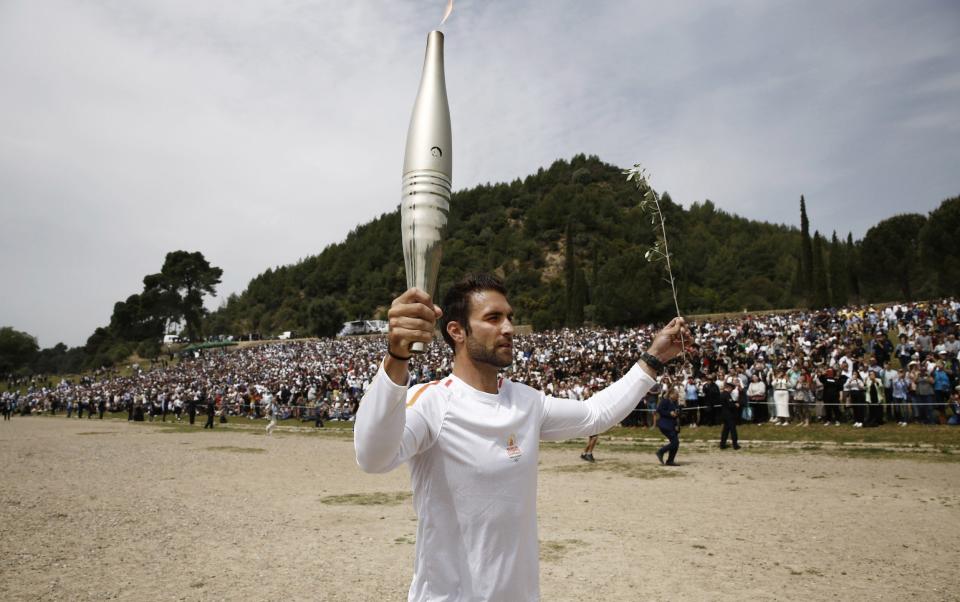
As for the stringent security measures, my pass received barely a glance, my passport went unrequested. Instead, everyone – dignitaries, officials, media, tourists, locals, the elderly walking slowly, babies in pushchairs – seemed to cascade down the hill, and into the archaeological site, via a side gate. There, order was restored. If, by “order”, you mean a flimsy dividing rope. Those with laminated plastic were sent to one side of it, to the rows of chairs on the “running track”. Those without were invited to posit themselves on the adjacent slope. If Hera – a Hellenic deity not known for her patience, with either her husband, Zeus, or anyone else – had been waiting for calm before allowing the flame to flicker in its crucible, irritated lightning might well have scorched the gloomy heavens.
But this is all part of the charm. The lighting of the Olympic flame is one of the great echoes of ancient times, all mystery and flair to the television eye. But it is also joyful mayhem, merrily accessible, for those who make their way to the Peloponnese to witness it. You do not even have to wait long for the following one. The next edition will be held at the start of 2026, ahead of the Winter Olympics in Milan and Cortina d’Ampezzo (Feb 6-22).
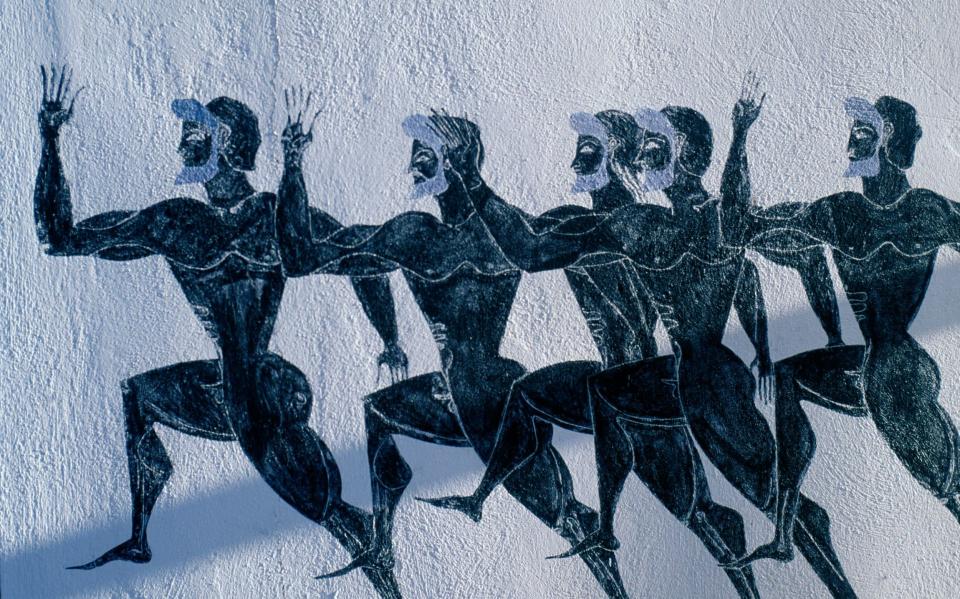
Not, of course, that it is definitively ancient. While blazes were lit in honour of Zeus when the original Olympics were held at the site (according to written record, every four years over the course of more than a millennium; 776 BC to AD 393), the Olympic flame ceremony, as seen last week, is a 20th-century concept. A giant fire did not burn in a modern sporting arena until Amsterdam in 1928. Nor did the lighting of the flame at Olympia (with a torch relay to and through the host nation to follow) begin with the revival of the Olympics in Athens in 1896. It was an innovation made within the grim context of the 1936 Berlin Games; the swastika flying, and Jesse Owens winning anyway.
And yet, amid the majesty of the ritual, on the west side of the Peloponnese, this does not seem to matter. Watching in person last week, seeing that initial burst of orange and red grow in strength, and seeing Mina pause to emphasise the importance of the moment, I could briefly – but entirely – believe that I was somewhere back in the third century BC.
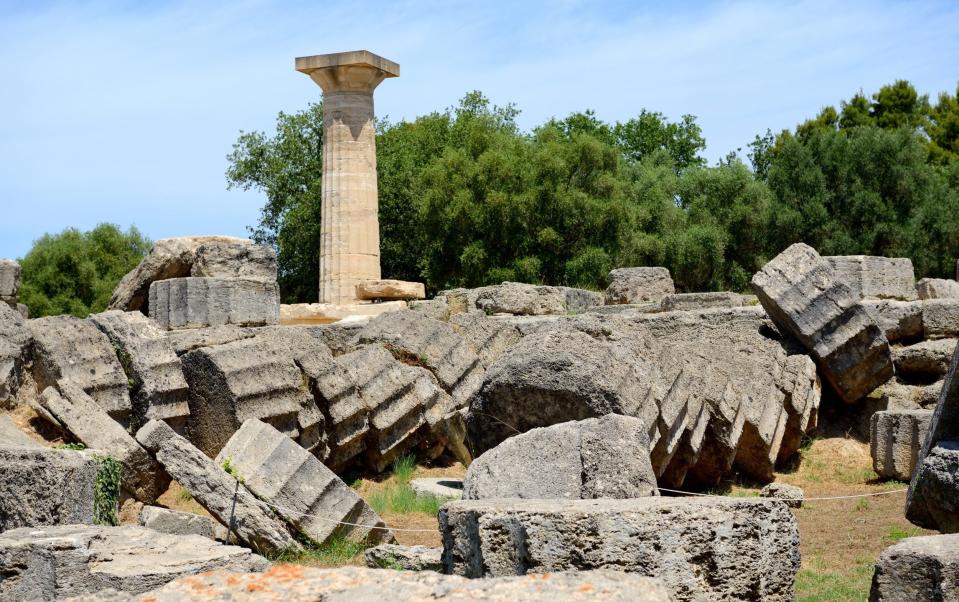
The setting helps. A tumble-down thing it may be, devoured over time by a series of earthquakes, but Olympia is one of Greece’s foremost ancient locations; arguably second only to the Parthenon on its Athenian crag. You do not even need to be there for its biennial festivities to appreciate its splendour. The Temple of Hera was the first footprint, in 590 BC; its destruction has only added to its fractured grandeur. The same can be said of the colossal Temple of Zeus – its columns brought down by seismic shocks in AD 522 and 551. But its magnificence is still obvious. That it – or, at least, the statue of the head deity of the Greek pantheon, which it once contained – was one of the “Seven Wonders of the Ancient World” becomes more and more clear the longer you let your gaze rest on it.
Nor is Olympia alone on a Peloponnese where the past greets you at almost every turn. Yesteryear is resplendent in the east of the peninsula, where the vast Theatre of Epidaurus, a wonder of the fourth century BC, has acoustics to rival the most advanced modern venues; a whisper dropped at the centre of the stage audible to the back row. It is there, too, in the north-east corner of the land-mass, where the remains of ancient Corinth once listened to the teachings of St Paul – and again, 25 miles to the south west, where Mycenae, its walls still sturdy, was one of the supposed start points of the Trojan War, Agamemnon climbing down from his throne to aid his brother, Menelaus. It is there close to the Peloponnesian heart – where the ruins of Sparta still glower at former rival Athens.
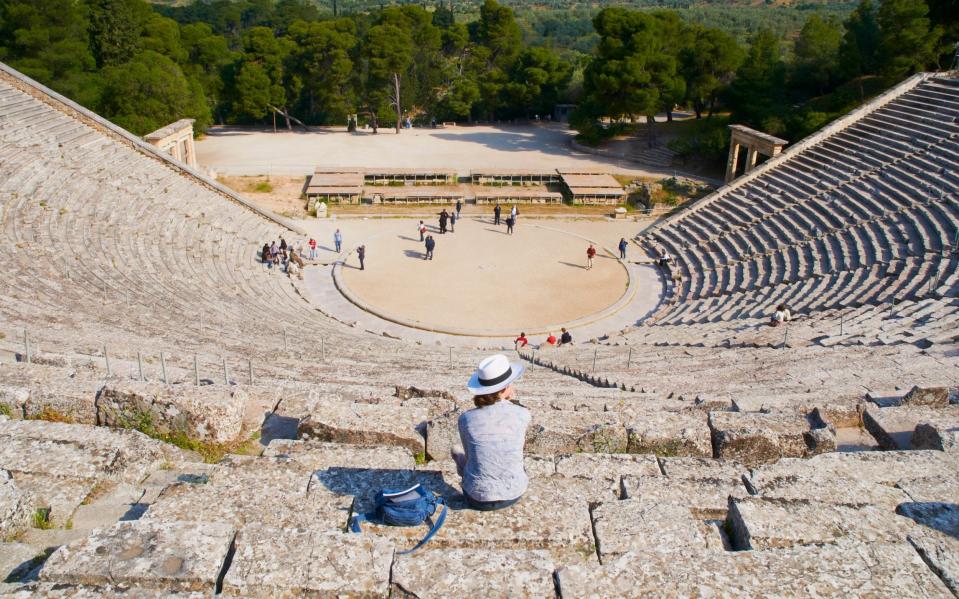
And it is there, especially, on the west side of the peninsula; an area that could fill several journeys in search of gods and heroes. And not just in Olympia. Fifteen miles north of Kalamata (which has the Peloponnese’s main airport), Messene is often confused with Agamemnon and its near-namesake, but has a tale of its own; one dating to 369 BC. The city was protected by fortifications so mighty that, five centuries later, the geographer Pausanias was all admiration, writing that “the walls of Byzantium and Rhodes are not as strong as the Messenian Wall”. They are partly still there. As is Bassae, a ruined citadel, 40 miles north of Messene, whose Temple of Apollo Epicurius could be the Parthenon’s brother (and has Unesco status to match).
Chora, near the coast, boasts the (purported) remnants of the Palace of Nestor; the folkloric King of Pylos may have ruled here around 1300 BC. Pylos itself has the Neokastro, a fortress of a later (16th-century) vintage. Its Ottoman-Venetian walls still brook no argument, even if another castle, six miles down the shore at Methoni, is a medieval guard dog of an even more daunting size.
Twenty years ago, the accommodation on the west coast might have felt like it belonged to a similar era; if not quite the 16th century, then scarcely the 21st either. But the arrival of the Costa Navarino complex in 2010 changed this, pinning a pair of luxury hideaways – a Westin property; the Romanos resort – to the beachside, eight miles north of Pylos. The effect has been revolutionary, drawing tourists to a section of the Greek waterfront that had been relatively overlooked. Many now come for the four golf courses laid out between olive groves. Two further five-star retreats – a W hotel, as well as a Mandarin Oriental – have been added this year, and will be fully functional in time for the summer.
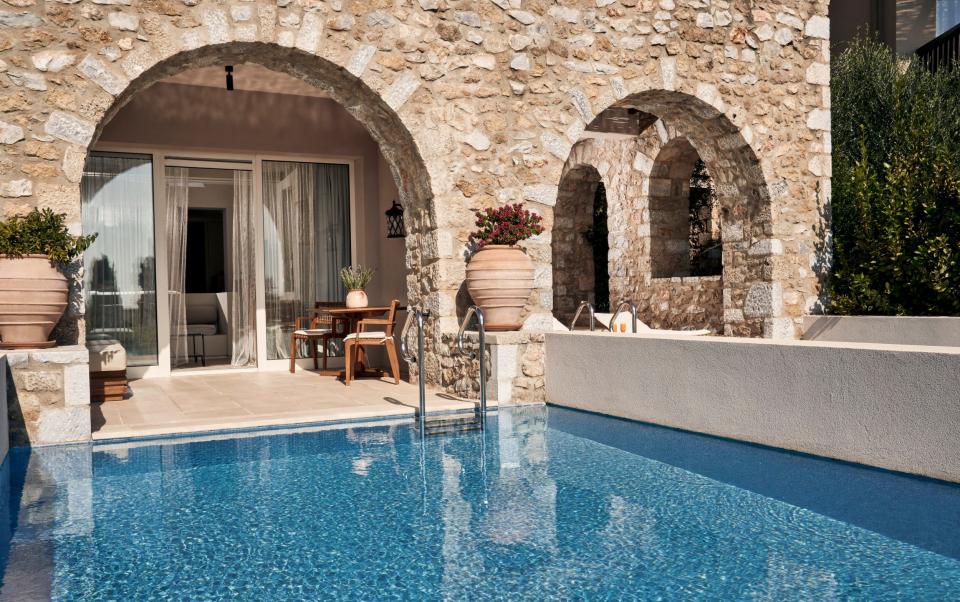
If this sounds like an intrusion into a pastoral past – golf courses rarely make themselves invisible – Costa Navarino has been careful to integrate itself into both its surroundings and 2024’s biggest sporting extravaganza. Last week, its International Olympic Academy Golf Course – whose position in the elevated Navarino Hills area of the complex makes for a gorgeous view of the sheltered waters and migratory birds of the Gialova Lagoon, which dominates the shoreline here – welcomed the Olympic torch relay. Groundskeepers looked on nervously as academy graduates Christos Pantazidis and Maritina Katsiroumpa exchanged the flame on the 11th green.
The process will continue from July 15 to Aug 16, via sports camps for children. Guests aged 6-15 will be able to try 10 Olympic sports (including football, beach volleyball, tennis, golf and football), with experienced coaches.
Nor is the complex aloof to the beauty around it. Flame-watching duties completed, I had the chance to enjoy another Olympic sport, riding into the countryside with resort cycling guide Dinos Karvelas. Peloponnese-born, he spoke of pedalling these roads in his childhood; quiet lanes where the only other vehicles were tractors, bumbling between fields. And after seeking the Kalamaris waterfall, a lovely cascade hidden in the trees, six miles from the hotel, we doubled back around the swampy edge of the lagoon – to Voidokilia Beach.
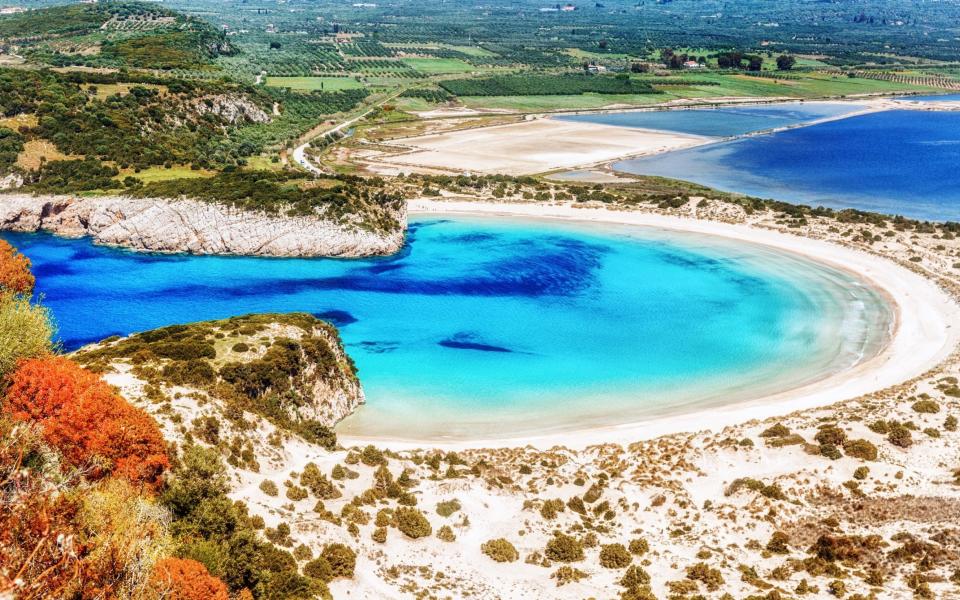
This perfect horseshoe may be Greece’s greatest arc of sand. In summer, it is crowded with all the organised chaos of Olympia on its ceremonial day. In April, it was deserted.
Except for ghosts. Perhaps Nestor himself, according to Dinos – who, pointing at the opening to the sea, cited the bay as the place, discussed in Homer’s Odyssey, where the questing Telemachus meets the King of Pylos while seeking his lost father, Odysseus. In a country that has given so much to the past, a mythological yesterday is never very distant.
Getting there
Chris Leadbeater travelled to Athens with Aegean Airlines (020 8759 3800; aegeanairlines.com), which flies to the Greek capital from Heathrow and Gatwick, from €59 (£51) each way. In summer, Kalamata Airport (30 miles away) is the easiest arrival point for Costa Navarino, with services from London, Bristol, Birmingham and Manchester.
Staying there
Double rooms at the Westin Resort at Costa Navarino start at €282 (£242) per night, including breakfast (0030 272 309 7000; costanavarino.com).
Further information
Visit ancientolympiamuseum.com; visitgreece.gr
Recommended
An insider's guide to Athens


